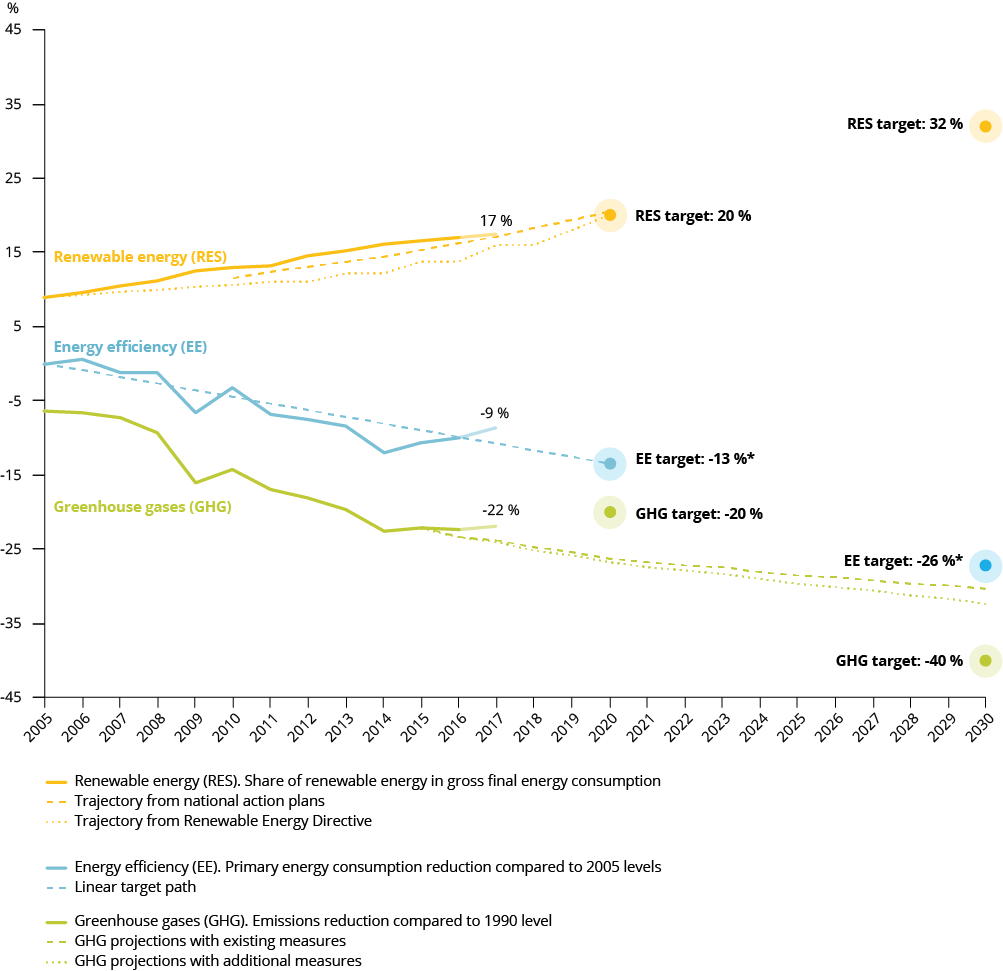The EEA’s updated assessment on the EU’s progress on renewable energy and energy efficiency targets completes this year’s ‘Trends and Projections in Europe: 2018: Tracking progress towards Europe’s climate and energy targets’ package. The report is based on the most recent reported and approximated data from EU Member States on greenhouse gas emissions, renewable energy uptake and energy consumption. Complementing the report are updated climate and energy country factsheets. The first part of the ‘Trends and Projections’ report, which includes an assessment of progress towards the EU’s climate targets, was published in October.
While the EU as a whole remains on track to meet its 2020 targets to reduce greenhouse gas emissions and increase renewable energy use, recent increasing trends in energy consumption need to be reversed in order to meet the 2020 targets. Renewed efforts will also be necessary to meet the 2030 climate and energy targets.
Progress on renewables
The uptake of renewable energy as part of the EU’s energy mix resulted in a 17.4 % share of renewables in gross final energy consumption in 2017, according to preliminary EEA data. This indicates that the EU remains on track to reach its target of a renewables share of 20 % by 2020. However, the pace of increasing renewables use was only up marginally from 17.0 % in 2016. There has also been insufficient progress towards the 10 % target for renewables in the transport sector by 2020. With 2020 approaching, the trajectories needed to meet the national targets are becoming steeper. Increased energy consumption and persisting market barriers are hindering the uptake of renewables in several Member States.
Preliminary EEA data for 2017 show that 20 Member States were on track to reach their individual targets on renewable energy by 2020 - a decline from 2016, when 25 countries were on track. In many countries, the slowing of progress is due to increases in total energy consumption, which caused the share of renewables in energy consumption to fall.
Energy efficiency hampered by increased consumption
Over the past decade, energy consumption generally decreased at a pace that could ensure the achievement of the EU’s 2020 targets on energy efficiency. However, in 2015, energy consumption in the EU began to increase, and the EEA’s preliminary estimates for 2017 indicate that both primary energy consumption and final energy consumption now lie above the indicative trajectory towards 2020. Notably, in 2016, growing demands for energy in the transport sector reached 33 % of final energy consumption in the EU. The continued growth in energy consumption, particularly in transport but also in other sectors, makes achieving the 2020 target increasingly uncertain.
Preliminary EEA data from 2017 show that 13 Member States are expected to have increased their primary energy consumption to levels above the trajectories to their 2020 targets. That is an increase of three countries from 2016. Member States will need to increase their efforts to bring the EU back on track and reverse the trend of increasing energy consumption, in particular in the transport sector.
Stepped up measures needed to meet 2030 targets
New EU-wide targets are set for 2030 in the areas of greenhouse gas emissions, renewable energy and energy efficiency, namely to:
- reduce the EU’s greenhouse gas emissions domestically by at least 40 % (compared to 1990 levels);
- increase the share of renewable energy sources to at least 32 % of gross final energy consumption; and
- achieve at least a 32.5 % improvement in energy efficiency (compared to the 2007 baseline).
The EEA’s Trends and Projections report indicates that the current trends will not be adequate to reach the 2030 targets, and additional and enhanced efforts will be necessary in the coming decade.
To this end, Member States will submit by the end of 2018 their first draft national energy and climate plans, including details on climate and energy objectives and policies that that will help them achieve the 2030 targets.

Notes: * The energy efficiency targets for 2020 and 2030 are defined as absolute targets, set at 20 % and 32.5 % below the level in primary and final energy consumption projected for 2020 and 2030 in the European Commission's 2007 Energy Baseline Scenario. In this figure, the target is expressed as a relative change compared with 2005 levels of primary energy consumption in the EU to show the required reduction in primary energy consumption over time. The year 2005 was chosen because it is used as a base year for GHG emissions (in the EU ETS and under the Effort Sharing Decision (ESD)) and renewable energy targets; this base year is not set in the energy efficiency legislation. It also corresponds to a peak in energy consumption in the EU.
The 'with existing measures' (WEM) scenario reflects existing and adopted policies and measures, whereas the 'with additional measures' (WAM) scenario considers the additional effects of planned measures reported by Member States.
Sources: EC, 2013a, 2007; EEA, 2018a, 2018b, 2018c, 2018d, 2018e, 2018f, 2011; EU, 2012, 2009a; Eurostat, 2018a, 2018b, 2018c.

Document Actions
Share with others